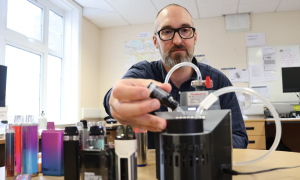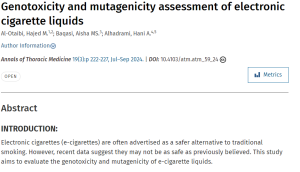The saying goes ‘Where there’s smoke, there’s fire.’
Vaping seems to be an exception to that rule, as vapes, or e-cigarettes, use electricity rather than fire to convert vape liquid with substances like tobacco, nicotine, CBD and THC, into a vapor that can be smoked or inhaled.
But does this difference mean that vaping doesn’t increase your risk for lung cancer and other health problems caused by traditional cigarettes? Is vaping truly a case where there’s smoke but no fire?
We spoke with Edwin Ostrin, M.D., Ph.D., to learn more about how vaping impacts the lungs.

Physician & Researcher
How is vaping different than smoking cigarettes?
Vapes differ from cigarettes, in part, because they heat liquids, not solids. Ostrin says cigarettes produce combusted plant matter that can deliver harmful chemicals directly to the lungs, leading to lung tissue destruction and lung cancer.
Still, while he says the vapor from e-cigarettes seems to be less harmful than tobacco smoking, he notes that the long-term health effects of vaping aren’t yet known.
“The effects aren’t really known and some of these epidemiological facts can take decades to really be noticed. We don’t have a great evidence basis because people haven’t been using these heavily for decades yet,” he says.
Another important distinction between traditional cigarettes and vape products is that vape products are not as regulated by the Food and Drug Administration (FDA). Ostrin says this can make it challenging for vape users to understand how much nicotine they are consuming and exactly what is in cannabis vape products like those containing THC and CBD.
Does vaping cause lung cancer?
We know that smoking cigarettes is a risk factor for several types of cancer, including lung cancer, so it is natural to wonder if vaping poses similar risks.
Unfortunately, Ostrin says that it’s still too early to tell exactly how vaping impacts the lungs.
“We don’t really know what we’re delivering into the lungs yet,” he says. “If there are little bits of damage that build up over years, we may not see it for decades.”
Ostrin says there are many chemicals in tobacco smoking that can cause the lung’s epithelial cells to undergo mutations that may lead to cancer. While he notes that vape liquid contains far fewer of these chemicals, it does contain some that can damage cells. However, he says that this hasn’t been shown outside of a laboratory setting.
“Some of these have been shown in a petri dish to cause cells to become inflamed and maybe even undergo mutation, but we don’t have yet the observational and epidemiologic data to show that there are cancers associated with it,” he says.
Cancer risk is only one of the vaping topics researchers are tackling. Ostrin says others include biological questions about vape liquid components and their impact on long-term lung health, whether vaping triggers diseases such as chronic obstructive pulmonary disease (COPD) and asthma, and epidemiologic questions.
“I think there’s an entire spectrum of research that is now kicking off,” Ostrin says.
How else does vaping impact the lungs?
There are several other lung health risks associated with vaping including some that you may have heard about on the news.
The first is EVALI, or e-cigarette or vaping use-associated lung injury. A large outbreak of EVALI occurred in 2019 when thousands were hospitalized with lung scarring and inflammation after using e-liquid thickened with Vitamin E acetate.
Ostrin says this tragedy is an example of how unregulated the vaping industry is.
“People can just go, ‘We’re going to add chemical X, Y, Z because it’s going to give more flavor, more quality,’ and they have no idea about the consequences and short- and long-term damage that these chemicals are causing,” he says.
Vaping has also been linked to a type of lung damage called bronchiolitis obliterans, or popcorn lung, which is caused by a chemical called diacetyl used to sweeten some vape liquids.
Additionally, because vape products are unregulated, they may have contaminants.
“Anybody can make this stuff and can refill these e-cigarettes,” Ostrin says. “We don’t know what sort of contaminants are in them, and there can be nasty stuff in there that can cause serious lung injury and body injury in general.”
Finally, many vape products contain nicotine. Ostrin says that it is concerning that young people who begin vaping could develop nicotine addictions and, subsequently, begin smoking cigarettes as vapes become more regulated and less available.
“Our biggest concern in terms of vaping affecting the lungs is that we’re going to be creating a new generation of nicotine addicts,” he says. “I don’t think we know that for certain, but it is certainly a worry.”
What should you do if you vape?
It may seem harmless to keep vaping, especially while research is still investigating exactly how it impacts the lungs, but quitting vapes and nicotine has concrete benefits.
“Quitting nicotine is going to save you money. It’s going to improve your lung health. It’s better for your heart,” Ostrin says.
He acknowledges that asking someone to quit nicotine is no small task.
“It’s one of the hardest things we ask our patients to do. It’s an incredibly addictive substance,” he says.
Adults interested in quitting tobacco can access resources including www.SmokeFree.gov and YESQUIT.org, while Texas teens can get free text support through This Is Quitting.
MD Anderson patients looking to quit smoking can use the Tobacco Research and Treatment Program.
“I think the best thing that any pulmonologist would recommend is to not inhale anything except fresh air and medications prescribed to you. Anything delivered into your lungs is a big wildcard,” Ostrin says. “Delivering foreign substances into the lungs is nothing but harmful.”
Source: MD Anderson Cancer Center










